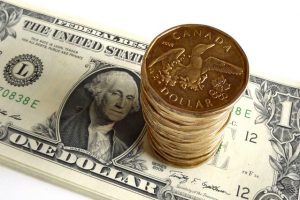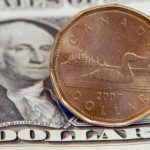 Yesterday’s trade saw USD/CAD within the range of 1.4116-1.4299. The pair closed at 1.4299, soaring 1.10% on a daily basis. It has been the 12th gain in the past 15 trading days and also the steepest one since January 15th, when the pair appreciated 1.21%. The daily high was a lower-high test of the high from January 22nd.
Yesterday’s trade saw USD/CAD within the range of 1.4116-1.4299. The pair closed at 1.4299, soaring 1.10% on a daily basis. It has been the 12th gain in the past 15 trading days and also the steepest one since January 15th, when the pair appreciated 1.21%. The daily high was a lower-high test of the high from January 22nd.
At 9:49 GMT today USD/CAD was losing 0.19% for the day to trade at 1.4273. The pair touched a daily high at 1.4326 at 8:30 GMT, undershooting the daily R2 level, and a daily low at 1.4263 during mid-Asian trading session. Resistance may be expected at the hourly 200-period EMA/the current daily high (1.4318/1.4326) and then – within the 1.4345-1.4360 area. A break and close above that area may target the psychological 1.4400 level. Support, on the other hand, may be received at the hourly 21-period EMA/the hourly 55-period EMA (1.4260/1.4265) and then – within the 1.4200-1.4215 area.
The Canadian dollar has recently been strongly pressured by a continuous decline in prices of crude oil. The commodity has fallen in 15 out of the past 27 trading days. Oil futures for March delivery were up 0.42% on the day to trade at $29.91 per barrel as of 10:02 GMT, after going up as high as $29.98 earlier. On January 20th the commodity touched a low of $26.19 per barrel, or a level unseen since early May 2003. Oil has slumped 19.29% so far during the current month.
On Tuesday USD/CAD trading may be influenced by the following macroeconomic reports as listed below.
Fundamentals
United States
S&P/Case-Schiller House Price Index
At 14:00 GMT Standard & Poors will report on the performance of its House Price Index, which measures the change in prices of single-family homes in 20 metropolitan areas across the US. The report serves as a gauge of the US housing markets health. According to the median estimate by experts, home prices in the 20 areas probably rose 5.7% in November compared to November 2014, after in October home values went up another 5.5%. If expectations were met, Novembers rate of increase would be the sharpest one since July 2014, when home prices climbed 6.7% year-on-year. Within a recovering economy, a sharper-than-projected gain in prices will usually have a moderate bullish effect on the local currency.
Services PMI by Markit – preliminary reading
Activity in the US sector of services probably increased at a slower rate in January from a month ago, with the corresponding preliminary Purchasing Managers Index coming in at a reading of 54.0, according to expectations. If so, this would be the lowest PMI level since December 2014, when the gauge was reported at a final 53.3. In December 2015 the services PMI was reported at a final 54.3, improving from a preliminary reading of 53.7. The PMI is based on data collected from a representative panel of more than 400 private sector companies, which encompasses industries such as transport and communication, financial intermediaries, business and personal services, computing & IT and hotels & restaurants. Values above the key level of 50.0 indicate optimism (expanding activity). In case a lower-than-expected expansion in services sector activity is reported, this would have a moderate bearish effect on the US dollar. The preliminary reading by Markit Economics is due out at 14:45 GMT.
Consumer confidence index by the Conference Board
Confidence among consumers in the United States probably remained unchanged in January, with the corresponding index coming in at a reading of 96.5, according to market expectations. It has been the highest index value since October 2015, when a level of 97.6 was reported.
This indicator measures the level of individuals confidence in the US economic development. It is considered as a leading indicator, as it gives an early insight into consumer spending, which accounts for most of the nations GDP.
The index has 1985 as a base year, when the base value was 100. This year was chosen, as it was neither a peak nor a bottom. The Consumer Confidence Index (CCI) is calculated on the basis of a household survey, which reflects consumers opinion on current conditions and future expectations regarding the US economy. Opinions on current conditions account for 40% of the index, while expectations of future conditions account for the remaining 60%. The surveys objective is to define consumer attitudes and buying intentions, while the data are filtered by age, income and region.
A sample of 5 000 households in the United States serves as a basis for the survey. Each month respondents give their opinion based on the answers to five questions: Current business conditions; Business conditions for the next six months; Current employment conditions; Employment conditions for the next six months; Total family income for the next six months. Respondents may answer each question as “positive”, “negative” or “neutral”.
Each of the five questions is given a “relative value”, or the positive responses are divided by the sum of the positive and negative responses. The relative value is then compared against each relative value from the base year (1985). The comparison of the relative values leads to the “index value” for all five questions. These index values are then averaged in order to form the value of the CCI.
In case the index came above expectations, this would have a strong bullish effect on the US dollar, as higher confidence suggests a greater willingness to spend and, respectively, an accelerated economic growth. The Conference Board research group is to publish the official index reading at 15:00 GMT.
Daily and Weekly Pivot Levels
By employing the Camarilla calculation method, the daily pivot levels for USD/CAD are presented as follows:
R1 – 1.4316
R2 – 1.4333
R3 (range resistance) – 1.4349
R4 (range breakout) – 1.4400
S1 – 1.4282
S2 – 1.4265
S3 (range support) – 1.4249
S4 (range breakout) – 1.4198
By using the traditional method of calculation, the weekly pivot levels for USD/CAD are presented as follows:
Central Pivot Point – 1.4306
R1 – 1.4502
R2 – 1.4886
R3 – 1.5082
S1 – 1.3922
S2 – 1.3726
S3 – 1.3342





